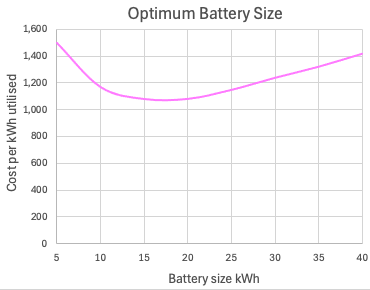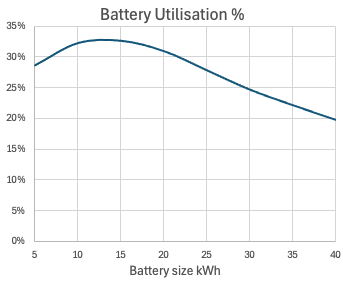Battery Size Modeling
It's a reasonable assumption that a slightly under sized battery is better than an oversized one because an undersized battery will be utilised more. However, the greater the undersizing the more it will hold back the cost saving potential of a solar system. Equally, an over sized battery will not limit savings potential but instead it will delay the breakeven point. So how do you define under and over sized in the first place?
The model we have developed finds the optimum battery size for the end user, in terms of the cost savings. It also estimates the size based on maximum utilisation. In short, the best utilisation and the most cost savings.
We’ll take you through an example:
The model requires some data to be input; the solar array size, which in this example is 6.75Wp. We also need to know the energy use profile of the end user, in this example it's a household with future plans for air source heating (ASHP). Currently they use about 5000kWh per year and it is estimated that the ASHP will add 12,000kWh.
The model takes this into account with an assumed usage pattern for the ASHP. It then runs the calculations. In this example, based on the household energy profiles and assumed ASHP demand the optimum battery size that saves the most is 18kWh. For battery utilisation the optimum battery size is 14kWh.




In this case we get two answers because utilisation is a measure how efficiently is the battery being used - the highest utilisation. The optimum battery size is calculated from the battery and installation cost divided by utilisation. In this example small batteries are more costly per unit of capacity than large ones, which shifts the optimum point towards higher battery capacities.
A further factor to consider is affordability and sometimes the optimum battery size can go beyond a project budget. Given that our original assumption is it's better to have a slightly undersized battery, my rule of thumb is choose a battery in between the utilisation and optimum size.
We use battery modelling to find the sweet spot between under and over sized batteries which helps to make better design decisions for our customers.
There are other factors to take into account such as budget and this often leads to choosing a battery that is on the smaller side of the optimum size. In the scenario above we would recommend a battery that is 15kWh, given the range of sizes available from the manufacturer.
Having a battery modelling capability is another tool we use to develop the best possible design and improve the efficiency of the system and savings for our customers.
